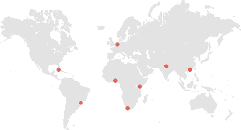Nakuru, 140 km from the Kenyan capital Nairobi, was founded in 1952. INTI’s interest in Nakuru is focused on the ways in which this city deals with food security and urban farming. Nakuru consists of a large number of farms, organized like an African version of Frank Lloyd Wright’s Broadacre City. It is an excellent example of how rural and urban features can merge together into one urban fabric. As such it puts forward a good example for other (Western European) New Towns aiming to include food production in their urban planning. Almere’s new extension Oosterwold is one of the locations for which Nakuru offers interesting lessons, on the urban level as well as on the level of the regional metabolism of food production and consumption.
Kenya is currently planning more New Towns than any other African country. This is due in large part to the new country-wide planning document Kenya Vision 2030. The Nairobi Metropolitan Region will have six New Towns constructed to reduce congestion within central Nairobi. The city also faces other challenge like sustainability, quality of life and food security.
While the challenges are great, so are the opportunities. The metropolitan region of Nairobi offers interesting research questions regarding the theme ‘Feeding’, because agriculture, the backbone of the Kenyan economy, is very present. Not only in the region but also in urban Nairobi, gardening is practiced everywhere: along riverbanks, roads and railway lines and under power lines. People garden on private plots and public land and sell their products on the local markets. In peri‐urban areas of Nairobi, farmers are switching to intensive horticulture on small plots as land is taken for housing.
Despite horticulture’s contribution to the urban food supply and livelihoods, agriculture has largely been excluded as a land use in Kenya’s cities and towns. During the colonial period, agriculture was officially designated as a rural land use and independent Kenya perpetuated that policy. While most local authorities tacitly accept the existence of urban agriculture, many, including the Nairobi City County, have enacted by‐laws that ban the cultivation of crops on public streets and unoccupied land, and the Ministry of Health is empowered to prohibit irrigation within and around townships. The objections to horticulture are based largely on health grounds; the use of raw sewage for irrigation has caused cases of faeces-coliform contamination of leafy vegetables, which made them unfit for human consumption.
However, the Ministry of Agriculture recently launched a project to promote urban and peri-urban agricultural cooperatives in Nairobi and 6 other cities. The National Land Policy, approved in 2009, recognizes the importance of urban agriculture, and the need for the zoning of land in ways that allow it. The 2011 Urban Areas and Cities Act requires that every city prepare an integrated development plan that should ‘provide a framework for regulated urban agriculture’. The governments’ strategy for the growth and development of the Nairobi metropolitan region to the year 2030 also calls for ‘active measures’ to prevent urban sprawl on prime peri-urban agricultural land, and proposes ‐ at long last ‐ to include agriculture among metropolitan land uses.
Metabolism of the Nairobi region
INTI’s research program in the metropolitan region of Nairobi is divided in an analysis, a research and a development part. Working with Dutch as well as Kenyan universities, the students will develop a map of the metabolism of the Nairobi region, in which the flows and locations of food related subjects will be assessed on metropolitan, peri-urban and urban level. Subjects include the production, the distribution, the logistics, the selling and the consumption of food.
The mapping will produce a tangible document, to be used to define focal points for urban planning and possible interventions to improve the food security of Nairobi. With this information a testing site in region Nairobi will be selected to develop in 2017. This testing site offers an opportunity for ‘learning by doing’. The context of Almere will serve as a chance for comparison. This will be done by knowledge exchange sessions and workshops with professionals and students from Kenya and the Netherlands. The developments relating to food and horticulture in Almere will be used in every stage to reflect on and learn from.
Partners: Technical University of Kenya, University of Nairobi, Dasuda, Placemakers, RUG, University of Amsterdam, Breda Hogeschool (NHTV), UN Habitat, IFHP, Nairobi City Department, local grass root organizations, WUR, Mazingira Institute, International Livestock Research Institute (ILRI), Go Down Arts centre



